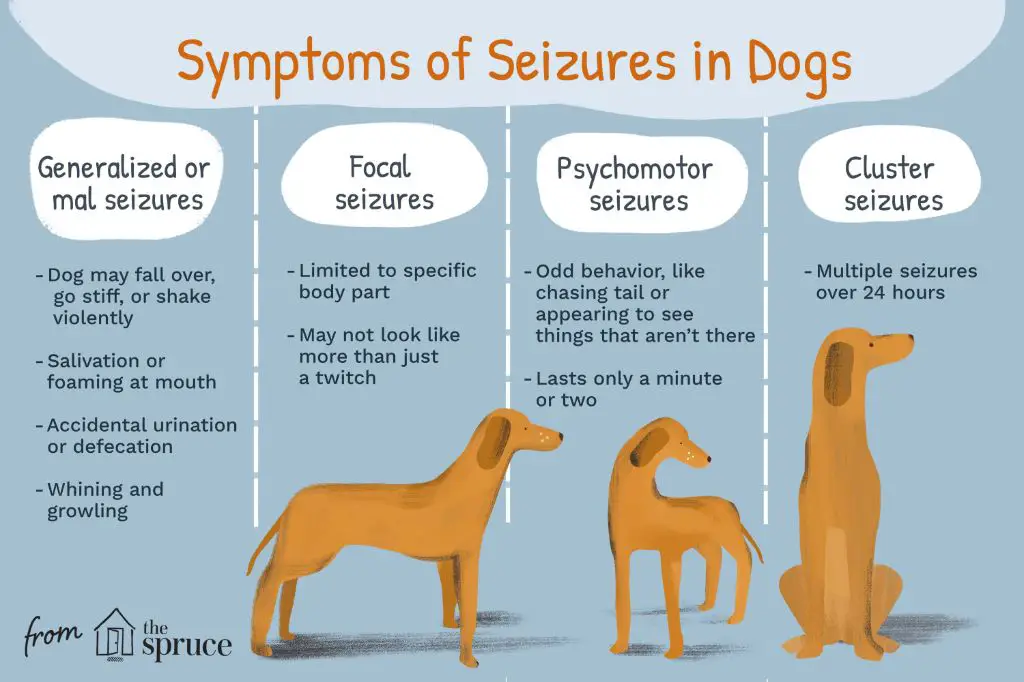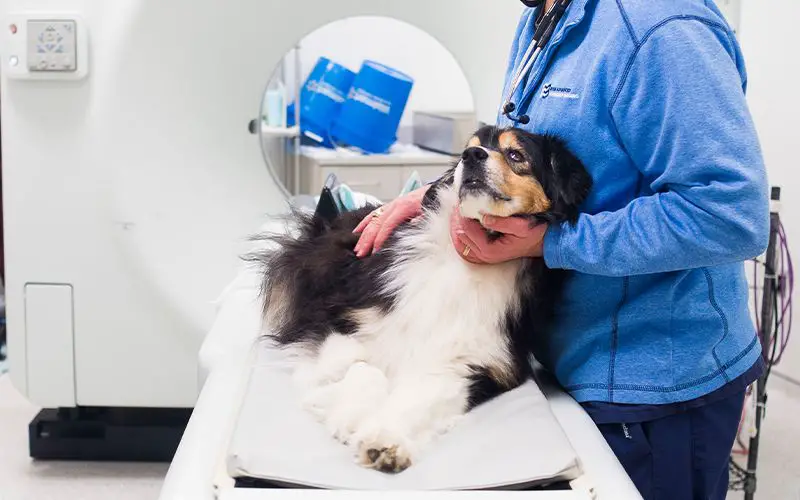Introduction
Seizures in dogs can be a frightening occurrence for pet owners. A seizure is defined as a sudden, uncontrolled electrical disturbance in the brain that results in temporary abnormal movements, behaviors, and sensations (Farke 2020). Seizures are relatively common in dogs, with around 5% of the overall canine population affected at some point during their lifespan (Farke 2020). While not all cases of seizures are serious, when seizures happen repeatedly or out of the blue, it is considered an emergency that requires urgent veterinary care.
Witnessing a seizure is distressing, but with the right information and care, many dogs can go on to live happy lives despite dealing with a seizure condition. By learning about the causes, symptoms, diagnosis and treatment of seizures in dogs, owners can be prepared and better assist their pets.
Types of Seizures

There are several different types of seizures that can affect dogs. The two main categories are generalized seizures and focal seizures:
Generalized Seizures
Generalized seizures affect the entire brain. The two most common types of generalized seizures in dogs are:
- Grand Mal Seizures: Also known as tonic-clonic seizures. These affect the entire body and consciousness is lost. They are characterized by muscle rigidity, paddling, chomping, salivation, and urination/defecation. After the active phase, dogs exhibit a post-ictal phase where they seem disoriented (Source: https://www.polltopastern.com/post/is-your-pup-experiencing-a-seizure).
- Petit Mal Seizures: Also known as absence seizures. These involve a short loss of consciousness, lasting less than 20 seconds, with few physical symptoms. The dog may stare blankly and seem dazed or confused (Source: https://www.pinterest.com/pin/648799890048079996/).
Focal Seizures
Focal seizures affect only one part of the brain initially. They can be:
- Focal Onset: Seizure activity begins in one area of the brain.
- Focal to Generalized: Localized seizure activity spreads and becomes generalized.
Symptoms depend on which area of the brain is affected. They may involve repetitive movements, unusual sensations, or behavior changes (Source: https://www.pinterest.com/pin/648799890048079996/).
Common Causes
Some of the most common causes of seizures in dogs include:
Idiopathic Epilepsy

Idiopathic epilepsy, meaning epilepsy of unknown cause, is one of the most common causes of seizures in dogs ([1]). It accounts for 50-60% of all seizure cases. Idiopathic epilepsy usually develops between 1-5 years of age and is suspected when no underlying cause can be found for the seizures ([2]). Certain breeds like Beagles, Keeshonds, and German Shepherds are more prone to idiopathic epilepsy ([3]).
Metabolic Disorders
Metabolic disorders like low blood sugar (hypoglycemia), kidney failure, and liver disease can cause seizures in dogs. Electrolyte imbalances and portosystemic shunts can also trigger seizures by disrupting normal brain activity ([1]).
Tumors
Tumors in the brain, such as meningiomas and gliomas, are an important cause of seizures in older dogs over 5 years of age. Seizures may be the first obvious clinical sign with brain tumors ([2]).
Poisoning
Ingestion of toxins like lead, organophosphates, hexitols like xylitol, and metaldehyde found in snail bait can cause seizures in dogs ([1]). Exposure to toxins like fluorouracil cream, ivermectin (especially in herding breeds), and fluoroquinolone antibiotics can also trigger seizures ([3]).
[1] https://www.aspcapro.org/resource/most-common-causes-seizures-dogs
[2] https://www.wedgewoodpharmacy.com/blog/posts/a-guide-to-seizures-and-convulsions-in-dogs.html
[3] https://www.kingsdale.com/what-are-the-causes-of-seizures-in-dogs
When to Seek Emergency Care
There are certain scenarios when you should seek emergency veterinary care if your dog has a seizure:
- The seizure lasts for more than 4 to 5 minutes (source: https://www.preventivevet.com/dogs/when-to-take-your-dog-to-the-emergency-vet). Prolonged seizures can lead to brain damage and other complications.
- Multiple seizures occur within a 24 hour period, also called cluster seizures (source: https://www.sentinelvse.com/blog/seizures-when-is-it-an-emergency/). Cluster seizures are dangerous and require immediate medical attention.
- Your dog has trouble breathing or shows signs of respiratory distress during or after the seizure (source: https://www.petsbest.com/blog/dog-seizures-when-to-worry-when-to-wait). Breathing difficulties can lead to oxygen deprivation and require emergency care.
In these urgent situations, take your dog to an emergency vet clinic right away. Timely treatment can help stabilize your dog and prevent further complications.
Diagnostic Tests

To determine the cause of seizures that seem to occur out of the blue, veterinarians typically recommend diagnostic testing. This allows them to rule out underlying conditions and identify potential treatment options. Some common diagnostic tests include:
Bloodwork: Routine bloodwork like a complete blood count and chemistry panel can identify infections, liver or kidney issues, electrolyte imbalances and more that may contribute to seizures, according to VCA Hospitals.
Urine testing: A urinalysis can detect signs of infection or kidney dysfunction that could potentially cause seizures, notes VCA.
MRI: An MRI allows veterinarians to visualize the dog’s brain and look for structural abnormalities, tumors, inflammation, or other conditions that may be causing the seizures, explains VCA.
CT scan: A CT scan provides detailed images of the brain and can also detect potential causes like brain lesions, according to the specialists at Vet Specialists.
Treatment Options

The most common form of treatment for seizures in dogs is anti-seizure medication. The main medications used include:
- Phenobarbital: This is often the first medication prescribed for dogs with recurrent seizures. It helps control seizure activity in most dogs. Possible side effects include increased thirst, increased appetite, and liver problems in some dogs. Regular blood tests are recommended to monitor liver function.
- Potassium bromide: This is often used with phenobarbital to control seizures that are not fully controlled by phenobarbital alone. Possible side effects include sedation, increased drinking and urination, vomiting, and diarrhea.
- Levetiracetam (Keppra): This is a newer seizure medication that is often used when phenobarbital does not fully control seizures. It has fewer side effects than other anti-seizure medications in dogs. It can cause sedation or restlessness when first starting treatment.
- Zonisamide: This is another newer medication option for treating refractory seizures in dogs. Side effects may include sleepiness, lack of coordination, vomiting, and decreased appetite.
Other options for managing seizures in dogs include:
- Treating any underlying illness: Many dogs have an underlying cause for seizures like a brain tumor, encephalitis, metabolic disease, or toxin exposure. Treating the underlying condition when possible can help control seizures.
- Making dietary changes: Some dogs benefit from a ketogenic diet high in fats and low in carbohydrates. This helps control seizures in some dogs.
- Considering surgery: For some brain tumors or singular epilepsy foci, surgical removal may help control seizures.
Working closely with your veterinarian to find the right medication protocol and making adjunctive changes like dietary modifications can help provide the best seizure control possible for your dog.
Living with a Dog with Seizures

Living with a dog that has seizures can be challenging, but there are ways to make it more manageable. It’s important to monitor and record your dog’s seizures to help identify any patterns or triggers. According to SuperTails, keeping a seizure diary noting the date, time, length, and characteristics of each seizure can be invaluable information for your veterinarian. You’ll also want to avoid any potential triggers like flickering lights, smoke, chemicals, stress, and overexcitement which may provoke a seizure.
When your dog experiences a seizure, it’s important to handle it properly for their safety. Keep your dog away from stairs or other hazards. Don’t try to restrain your dog or put anything in their mouth during the seizure. Stay calm, speak softly, and gently stroke your dog to provide comfort until the seizure passes. Afterwards, keep your dog cool and monitor their breathing until they recover. Providing a safe, loving, and low-stress environment is key for caring for a dog with seizures.
Prognosis
The prognosis for dogs with seizures depends on the underlying cause. With idiopathic epilepsy, the prognosis is generally good with appropriate treatment. While epilepsy itself is not curable, the seizures can often be well-controlled with anti-seizure medications like phenobarbital or potassium bromide (KBr) [1]. Most dogs can live a good quality of life with medication and have few to no seizures.
However, epilepsy is a chronic condition and lifelong medication and monitoring is typically required. Some dogs may become resistant to medications over time or experience breakthrough seizures. Frequent cluster seizures or status epilepticus can indicate poorer control. Overall, studies show idiopathic epilepsy carries a good prognosis, with over 60% of treated dogs experiencing complete remission or only infrequent seizure activity [2].
When seizures are due to an underlying condition like a brain tumor, inflammation, or toxicity, the prognosis depends on the treatment of the primary disease. With medication to control seizures and addressing the underlying trigger, many dogs can still have a good quality of life.
Prevention
There are several ways to help prevent seizures in dogs, including proper nutrition, avoiding toxins, and selective breeding.
Ensuring your dog eats a nutritious, balanced diet is crucial for seizure prevention. According to Discover Magazine, nutrient deficiencies or imbalances can trigger seizures. Feeding your dog high-quality dog food designed for their life stage, size, and activity level helps prevent deficiencies. Adding an omega-3 fatty acid supplement may also help reduce seizures. Avoiding or limiting ingredients like preservatives, artificial colors, and excess salt can also promote neurological health.
Preventing exposure to toxins is another important way to reduce seizures. According to the AKC Canine Health Foundation, toxins like lead, organophosphates, and metaldehyde found in pesticides, herbicides, and slug bait can cause seizures in dogs. Keeping your home and yard free of toxins helps avoid exposure.
Selective breeding of dogs is beneficial for reducing the prevalence of idiopathic epilepsy, which is the most common cause of seizures. Reputable breeders should screen their dogs for genetic conditions including epilepsy that could be passed to puppies. Avoiding breeding carrier dogs helps lower seizure incidences over generations.
When to Euthanize
One of the most difficult decisions dog owners face is determining when it is time to euthanize a beloved pet suffering from frequent seizures. Unfortunately, there comes a point for some dogs when seizures become refractory – meaning they do not respond to medical treatment. This leads to diminished quality of life and significant risk of injury.
According to the American College of Veterinary Internal Medicine, euthanasia may be warranted when a dog experiences violent cluster seizures multiple times a week despite aggressive treatment. These episodes can result in severe physical trauma, including head injuries, lacerations, and broken bones. Repeated brain hypoxia from prolonged seizures also causes cumulative neurological damage over time.
Euthanasia is often merciful when a dog’s seizures are no longer controlled by any combination of anti-epileptic drugs, and the dog injures itself during violent convulsions. As one study published in Frontiers in Veterinary Science states, the risk of mortality rises significantly when cluster seizures last more than 5 minutes. Ultimately, euthanasia spares the dog further pain and preserves dignity at the end of life.
While euthanasia is heartbreaking, it provides relief when all medical options are exhausted and seizures frequently compromise quality of life. Pet owners should thoughtfully weigh input from the veterinarian when making this difficult choice. Support from family, friends, and care team can help navigate the painful decision to say goodbye.
